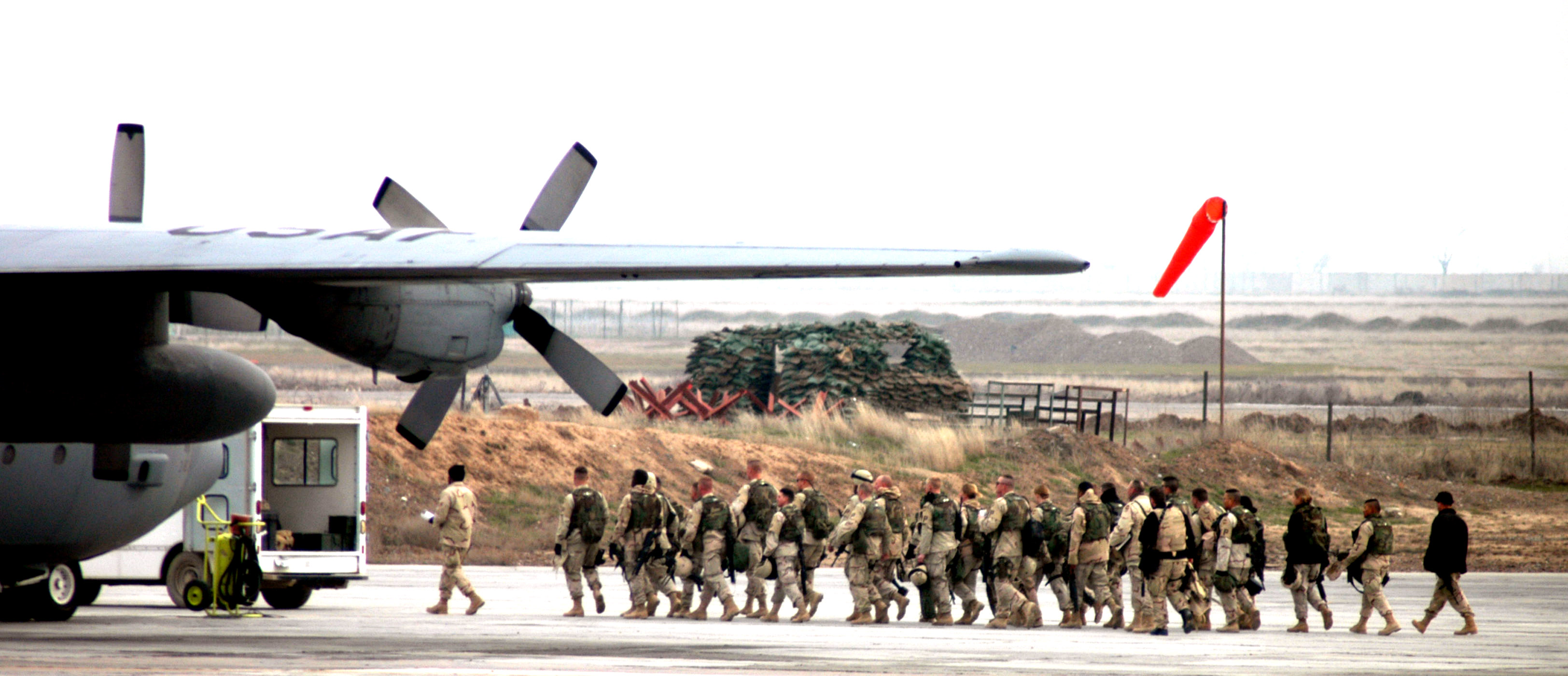Karshi Khanabad (K-2) Air Base
Karshi-Khanabad Air Base, also known as K-2, or Camp Stronghold Freedom, is a former Soviet air base located in Uzbekistan. It was used by the U.S. Army, Air Force, and Marines to support missions into Afghanistan. The base was one square mile in southeastern Uzbekistan, between Tajikistan and Turkmenistan.
Veterans who were deployed to K-2 may have encountered various hazardous exposures that can have long-term health implications.

Army troops follow an airman at Karshi-Khanbad Air Base
United States Air Force, photo by Tech. Sgt. Scott T. Sturkol
The U.S. military occupied the base from 2001-2005. K-2 is currently the home of the 60th Separate Mixed Aviation Brigade of the Uzbek Air Force.
Potential Exposures
All Service members at K-2 may have encountered several hazardous exposures:
Jet fuel: Exposure to jet fuel may have occurred as a result of a leaking Soviet-era underground jet fuel distribution system.
Volatile organic compounds - Air samples collected during environmental assessments contained concentrations of volatile organic compounds from jet fuel vapors that did not exceed military exposure guidelines or other health exposure criteria.
Particulate matter and dust –All Service members who served in the Southwest Asia theater of operations, Afganistan, Syria, Dijibouti, or Uzbekistan were exposed to particulate matter and dust. The levels in the air varied depending on the season and weather conditions.
Depleted uranium – Several years before the U.S. occupied K-2, Soviet missiles were destroyed there, contaminating some areas of surface dirt with low-level, radioactive, depleted uranium.
Asbestos – Asbestos was present in roof tiles and dirt but was not detected in air samples.
Lead- based Paint: K-2’s one-stop, in-processing center was the only structure identified on the base with lead-based paint.
Environmental assessments also confirmed the absence of chemical warfare agents and ionizing radiation on K-2.
The Karshi-Khanabad Airbase Exposures web page by the Defense Health Agency contains more information about potential exposures.
Additional information on K2 can be found at the Health.mil website: Environmental Hazards Study: Mortality Among U.S. Service Members Deployed to Karshi-Khanabad Air Base, Uzbekistan | Health.mil.
Research
The Department of Defense (DOD) conducted an initial study to look at cancer outcomes among Service members deployed to K-2 and found a higher risk of malignant melanoma and neoplasms of the lymphatic and hematopoietic tissues (excluding Non-Hodgkin Lymphoma and Leukemia). These results, however, were based on only a few cases of each type of cancer and should not be viewed as definitive evidence of an association with service at K-2.
DOD has also completed an all-cause mortality assessment in the K2 cohort. This report can be found at: K2-Mortality-Study (health.mil).
Both DOD and VA continue to assess the health effects of those deployed to K-2.
Launched in the Summer of 2022 and operated by VHA’s Health Outcomes Military Exposure (HOME), the K-2 Surveillance Program (K2SP) will analyze disease and deaths over the next 10 years as they potentially relate to exposures at the K-2 Air Base.
The findings from the initial analyses from the K2 Surveillance Program were presented in March 2024 at the annual meeting of AMSUS, the Society of Federal Health Professionals.
K-2 Community Forum
Semiannual Community Engagement Forums (CEF) provide an opportunity for Veterans to voice concerns and listen to those of other K-2 Veterans. HOME encourages K-2 Veterans to join and participate in this communal space where health concerns can be heard and responded to on a consistent basis.
Depleted Uranium Testing
Veterans who served at K-2 are eligible to schedule and receive a urine assay to test for the isotopic signature of DU. To schedule an appointment to be tested, please contact an Environmental Health Coordinator near you. There is no cost to you for the DU laboratory test.
Airborne Hazards and Open Burn Pit Registry
K-2 Veterans are now auto-enrolled in the redesigned Airborne Hazards and Open Burn Pit Registry. Researchers, including experts at VA, are actively studying airborne hazards like open burn pits and other military environmental exposures to better understand potential long-term health effects and provide Veterans with needed care and services.
Health concerns?
If you are concerned about possible health issues related to service at K-2, talk to your health care provider. Find out how you can apply for VA health care.
Compensation for health problems
Veterans may file a claim for disability compensation for health problems they believe are related to service at K-2. These claims are decided on a case-by-case basis. File a claim online.
Download free viewer and reader software to view PDF, video and other file formats.





















